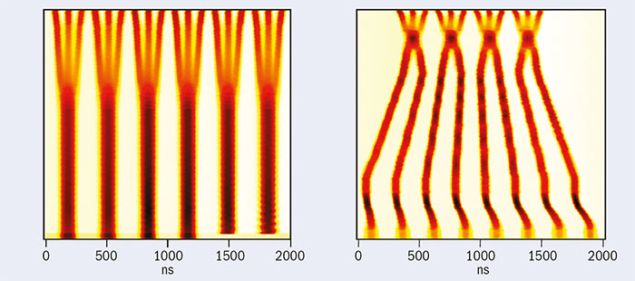
The LHC relies on the injector complex to deliver proton beams with well-defined transverse and longitudinal characteristics, which fold directly into luminosity performance. On 16 July, LHC Operations made use of a new bunch-production scheme called Batch Compression Merging and Splitting (BCMS) which offers significantly lower transverse beam size. Although the LHC has already broken several performance records this year, the new scheme increased the peak luminosity of the LHC by around 20% and set a new record of 1.2 × 1034 cm–2s–1.
Proton beams emerging from Linac2 in the LHC’s accelerator chain are injected sequentially into each of the four rings of the Proton Synchrotron Booster (PSB) using a multiturn injection process. The total beam intensity per ring is controlled by varying the number of PSB turns during which beam is injected. The transverse emittance (a combined measure of the beam’s transverse size and angular divergence) is also determined by the multiturn nature of the injection process, and in general more injected protons translates to a larger transverse emittance. The eventual number of bunches and their temporal spacing are governed by radio-frequency (RF) gymnastics in the Proton Synchrotron (PS), which injects protons into the Super Proton Synchrotron (SPS) – from where they are fed into the LHC.
The nominal scheme for LHC beam production is based on injecting four and then two bunches from the PSB into the PS. The six PSB bunches are injected into the PS RF “harmonic 7”. The harmonic number is the number of bunch slots – or RF buckets – available in the full circumference of the ring, and this parameter is fully controlled by the RF system. Each of the six bunches is then split into three to reach harmonic 21, and then split into two twice more to result in 72 bunches spaced by 25 ns. To reduce the emittance, it is desirable to inject fewer turns from Linac2 into the PSB and to reduce the bunch-splitting factor in the PS, while still delivering nominal bunch population for 25 ns beam.
The new BCMS scheme makes maximal use of the PSB rings by taking eight bunches (four plus four) into the PS on harmonic 9. A batch compression is then performed by incrementing the harmonic number from harmonic 9 to 14, after which a bunch-merging puts the harmonic number back to 7 (see figure). From this point onwards, the RF gymnastics are similar to those used for the nominal beam but the number of bunches produced is different: eight bunches are merged into four, split by three, two and two again. This results in 48 bunches spaced by 25 ns being injected into the SPS, which is less than the nominal 72 bunches. The scheme wins by taking lower intensities and thus smaller bunches into the PS, and then establishing the basis for the nominal bunch population in the compression and merging process.







